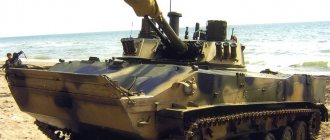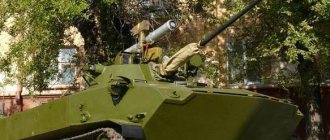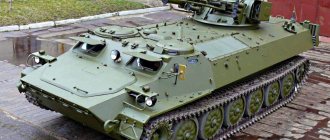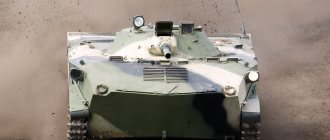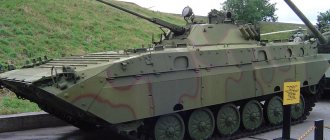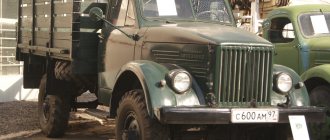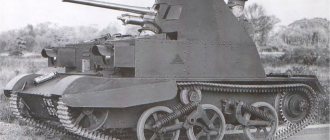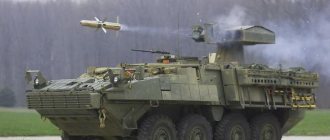GAZ-14-05 “Chaika”: Greetings from the past
| R-145BM | |
| R-145BM "Chaika" of the 4th Separate Guards Tank Kantemirov Order of Lenin Red Banner Brigade | |
| R-145BM "Chaika" | |
| Classification | Command and staff vehicle |
| Combat weight, t | 10,475 |
| Crew, people | 5 |
| Story | |
| Manufacturer | |
| Basic operators | |
| Dimensions | |
| Case length, mm | 7220..7560 |
| Width, mm | 2825 |
| Height, mm | 3360 |
| Base, mm | 4240 |
| Track, mm | 2370 |
| Ground clearance, mm | 475 |
| Booking | |
| Armor type | bulletproof |
| Mobility | |
| engine's type | 2 x GAZ-40P |
| Engine power, l. With. | 2 x 90 |
| Cruising range on the highway, km | 500 |
| Wheel formula | 8 × 8 / 4 |
| Suspension type | individual torsion bar |
| Climbability, degrees. | 30 |
| Ditch to be overcome, m | 2,0 |
| Fordability, m | floats |
| Media files on Wikimedia Commons | |
R-145BM "Chaika"
- Soviet command and staff vehicle. Created on the basis of the BTR-60PA armored personnel carrier.
EIGHT-WHEEL “SEAGULL”
The command post vehicle (CSM) R-145BM "Chaika-BM" was created on the basis of the BTR-60PA armored personnel carrier and is designed to provide control and organization of radio communications at mobile control points via one short-wave (HF) and two VHF channels both in motion and in the parking lot. In this case, covert communication can be carried out over one of the radio stations using classified communication equipment (CAS). The KShM can operate both in the US PU satellite communication system and autonomously.
The body of the armored vehicle has: a commander's compartment in the front and a hardware compartment in the rear. The commander's compartment contains the commander's, communications officer's and driver's consoles, a loudspeaker, a radio station with a whip antenna and a telescopic mast. The hardware compartment contains radio stations with power supplies, a matching device for the radio station with a whip antenna, a radio operator's console, balancing and matching blocks, an external matching device for the radio station R-130M "Boxwood" and the device R-012M.
KShM R-145BM army of the GDR
Command and staff vehicle based on the BTR-60PA of the Armed Forces of the Republic of Belarus
A command and staff vehicle based on the BTR-60P on the territory of the Ryazan Higher Military Command School of Communications
KShM R-145BM allows you to maintain reliable two-way communication on moderately rough terrain when moving and while parked using the R-130M shortwave radio station with single-sideband modulation at a distance of 75 - 350 km . In addition, there are two VHF radio stations with frequency modulation: R-111 “Binom-M” and a wide-range radio with automatic tuning to one of four pre-prepared frequencies R-123MT “Magnolia”. The first allows you to maintain reliable communication at a distance of 35 - 75 km, and the second - at a distance of 20 - 40 km. For covert communication, the T-219 ZAS is provided.
In the Soviet Union, the vehicle was supplied to the headquarters of tank, motorized rifle, artillery regiments and formations.
A column of armored vehicles led by KShM R-145BM
KShM R-145RB were widely used during the war in Afghanistan and Chechnya. But by that time, the BTR-60P, on the chassis of which the command and staff vehicle was made, was morally obsolete. During battles, R-145BMs often broke down.
Moreover, these vehicles were very visible, especially in populated areas, so the militants sought to disable them first. This led to disruption of troop control.
BASIC DATA KShM R-145BM
After the collapse of the Soviet Union, many P-145BMs remained in its former republics, including Ukraine, but their use in battles against the Donetsk and Lugansk People's Republics was not reported.
Nowadays it is used, in particular, in the Armed Forces of the Republic of Belarus.
N. VASILIEV
We recommend reading
- DYRENKOV'S ARMORED VEHICLES Along with tank building, armored vehicle manufacturing also developed quite rapidly in the Soviet Union in the 1930s. If in the previous decade only one armored car was put into service -...
- Why a truck crane is so necessary for work Sooner or later, many organizations are faced with the need to transport, unload and load, as well as lift large and heavy loads to a height. Truck crane rental in…
Content
The main purpose of the R-145BM is to organize radio communications in mobile control points [1].
Armored hull and turret
The inside of the machine body has two compartments. In the front of the vehicle there is a command compartment, in the rear there is an equipment room [2].
In the commander's compartment there are [2]:
- Commander consoles;
- Officer's console;
- Driver's remote control;
- Speaker;
- Radio station with whip antenna;
- Telescopic mast.
The hardware compartment contains [2]:
- Radio stations and power supplies for them;
- Antenna matching device for the R-111 radio station with a whip antenna;
- Radio operator's console;
- Balancing and matching block;
- Remote matching device for the R-130M radio station;
- Device R-012M
Surveillance and communications equipment
The R-145BM maintains reliable two-way communications over moderately rough terrain [1].
The following radio stations are installed in the car [3]:
- R-130M;
- R-111;
- R-123MT.
R-130M
| Table of performance characteristics of the components of the R-130M radio station [3] | |||||||||
| Antenna type | Range, km | Frequency range, MHz | Nature of work | ||||||
| Anti-aircraft radiation antenna, symmetrical | 75 | 2,00 — 10,50 | Parked and on the move | ||||||
| Anti-aircraft radiation antenna, asymmetrical | 45 | 1,50 — 10,50 | Parked and on the move | ||||||
| Symmetrical dipole antenna | 350 | 1,50 — 10,99 | In the parking lot | ||||||
The command and staff vehicle R-145BM "Chaika" is a mobile complex mounted on the basis of the armored personnel carrier BTR-60PA (BTR-60PU), and includes a dual simplex version of the VHF radio station R-111, VHF radio station R-123MT, HF radio station R -130M, calling device R-012M, CA equipment, a set of switching equipment, a set of antenna mast devices and a power supply system.
The crew of the car consisted of four people. The vehicle was supplied to the headquarters of tank, motorized rifle, and artillery regiments and formations.
R-145BM
has 3 compartments: front (command), middle (hardware) and rear (power). — in the front compartment there are two commander’s workplaces, an officer’s workplace and a driver’s workplace, the R-123MT radio station, switching and official communication equipment are located; — in the middle compartment there are two workstations for radio operators and are located: radio stations R-130M, R-111, SA, switching and service communications equipment; — in the rear compartment there are two GAZ-23F engines, a power take-off system from the left BTR engine with a G-290 on-board KShM generator, a power take-off system from the right BTR engine with a G-2906 on-board BTR generator and other equipment.
Radio stations R-111, R-123MT and R-130M can operate independently and simultaneously when selecting frequencies according to the table of operating frequency options.
Control of radio stations in radiotelephone mode can be carried out from two workstations of radio operators, two workstations of a commander, one workstation of an officer and from two TA-57 telephone sets connected to the command and staff vehicle using two wire lines up to 500 m long each.
Work through the SA equipment is carried out from one workstation of the radio operator, two workstations of the commander and from one telephone set TA-57.
Circular and selective transmission and reception of call signals on four KShM radio stations is provided using the R-012M device.
Combat capabilities of the KShM R-145 BM:
- simultaneous and independent communication in motion and in a parking lot by radio stations of the main set; - taking control of a radio station prepared for operation in mode A independently by any crew member directly from his workplace; — remote control in mode A of two KShM radio stations via two remote control lines from remote TA-57 telephone sets at a distance of up to 500 m; - remote control in mode B of one of the KShM radio stations from a remote TF device at a distance of up to 500 m, - taking control of a radio station prepared for operation by the commander and officer (in mode B - only by the commander), upon request through the radio operator of the P1 workplace; — loud-speaking reception of the KShM radio stations at the commander’s first workplace and in the equipment compartment; — signaling in the command compartment that the radio channel is ready to operate in mode B; — signaling about the operating mode and occupation of the radio channel in mode B; — internal selective communication between all crew members; — circular internal communication between officer commanders and crew members; — operation of KShM radio stations with the same type of radio stations at any time of the year and day, on moderately rough terrain, depending on operating conditions, selected frequencies and the type of antennas used, over distances: R-130M - up to 350 km; R-111 - up to 75 km.
The time for deployment and preparation of the CVM for communication is 1-35 minutes. (depending on the type of antennas used and power sources).
Surviving copies
Bulgaria - National Military History Museum in Sofia. Russia: Military Historical Museum of Artillery, Engineering Troops and Signal Corps in St. Petersburg. Technical Museum G.K. Sakharov in Togliatti Museum of Technology of Vadim Zadorozhny (photo) Czech Republic - National Military Museum in Zamárdi. Ukraine - Pedestal at the Institute of Communications.
Command and staff vehicle "Svityaz" based on the BTR-70Di-02
The Svityaz command and staff vehicle (CSV), based on the BTR-70Di, is a wheeled, amphibious, armored vehicle, with all drive wheels, equipped with two powerful FPT “IVECO” diesel engines (Euro-3). It has high dynamic qualities, increased cross-country ability and a smooth ride. Equipped with a filter and ventilation unit, air conditioning, heater, and lighting systems.
The Svityaz KShM is designed to provide command and control of troops and organize communications at the operational-tactical command and control level while on the move, afloat and at a stop, both autonomously and as part of a communications center.
Prototypes of the Svityaz KShM have passed preliminary tests and are now preparing for state tests, which will take place in October-November. “Svityaz” was developed as a logical continuation of integrated hardware communications (CAC). If the CAS deploys the infrastructure of the control center communication center, then the KShM will be able to connect to these data transmission networks and expand them.
With the help of Svityaz, units will be controlled via radio, as well as via such rather new types of communication for the army as WiMAX and WiFi. Video surveillance of objects and transmission of video information will also be provided. Svityaz uses radio data transmission using IP protocols for the first time. During the development of the KShM, approaches to the structure of the machine changed several times. And the latest version should be successful.
The KShV based on the BTR-70 was chosen as the main one for the Ukrainian army. The BTR-4 base, at best, will be used as a base for the promising “second stage” CVV. As is known, in 2012, Ukraine announced the delivery of one BTR-70Di to Sudan, and it is believed that this was just a KShV based on it. It may well be that we are talking about one of the Svityaz prototypes.
Communication system standards:
NATO: STANAG 5066 EUROCOM: ITU-T G.703.2048KBPS Telephone network ISDN: 2-wire. 4 wire
SPECIAL EQUIPMENT Special equipment includes communication, automation and technical support systems:
Radio station KB P-1150 VHF radio station R-030U LAN switch type A-101 Router A-201 Radio gateway R-1261 with VoIP Server Navigation tools Automated workstations
The command and staff vehicle provides:
radiotelephone communication and data transfer from workstations with correspondents of KB and VHF radio networks; radiotelephone communication and data transfer from remote workstations; radiotelephone communication between radio network correspondents and telephone network subscribers; data transfer between the PCs of radio network correspondents and the PU PC; voice communication between KShM workstations; data transfer to local computer network of the KShM access to the telephone network of the control point organization of two remote workstations remote control of KShM facilities from remote workstations.
Chassis characteristics
Weight 12250 kg Crew 2 people. Landing party 3 people. Length 7595 mm Width 2800 mm Height 2300 mm Ground clearance 490 mm Maximum speed on the highway 100 km/h Speed on water 10 km/h Cruising range on the highway 860 km
Sources: https://bmpd.livejournal.com/631503.html https://warfiles.ru/show-40569-raskryty-podrobnosti-o-novoy-ukrainskoy-kshm-svityaz.html https://btrmz.com/ ru/ptodukt/lightbtr/btr70/svitaz
Armored personnel carrier BTR-60
The world's first mass-produced four-axle wheeled all-wheel drive amphibious armored personnel carrier, which laid the foundation for a whole family of domestic armored vehicles. Developed at the GAZ Design Bureau since 1956. Adopted by the Soviet Army by order of the Ministry of Defense No. 0202 of November 13, 1059. Serial production was carried out at GAZ from 1960 to 1967.SERIAL MODIFICATIONS:
BTR-60P (GAZ-49) - basic version. Welded load-bearing body, open at the top, equipped with a removable canvas top. For firing from personal assault weapons, there are 6 embrasures on the sides. Armament: SGMB machine gun (later PKB) on a special bracket on the front or side plates of the hull. Daytime surveillance devices B-1, night vision devices TKN-1 and TVN-2. Two GAZ-49 engines with a power of 90 hp. every. The wheels of the first and third axles are driven through an independent transmission from the right engine; from the left engine - the wheels of the second and fourth axles. Movement afloat is using a jet-type propulsion system. The combat weight of the vehicle is 9.9 tons. Crew 2 people, landing force 14 people. Radio station R-113. Serial production from 1960 to 1963.
BTR-60PA (GAZ-49A) - a fully armored sealed body. There are four hatches in the roof for boarding and disembarking the crew and troops. The reliability of operation of individual components of the chassis and power transmission has been increased. Combat weight 10.2 tons. Landing force 12 people. Serial production from 1963 to 1966.
BTR-60PA1 - improved power plant and power transmission units. Combat weight 10.3 tons. Radio station R-123. Serial production in 1965 -1966.
BTR-60PA
BTR-60PB
BTR-60PB (GAZ-49B) is the most successful and most widespread modification. On the roof of the hull there is a rotating turret with a coaxial installation of KPVT and PKT machine guns and a PP-61A (later PP-61AM) optical sight. Vertical firing angle +30°…-5°. ESD system. Serial production from 1966 to 1976.
Armored personnel carriers of the BTR-60 family began to enter service with the troops in the early 60s, quickly displacing the BTR-152 from the “first echelon” divisions. Somewhat later, these vehicles went into service with the Marine Corps and border troops. In total, according to Western data, 25,000 armored personnel carriers of all modifications were manufactured.
A significant number of special-purpose vehicles were produced on the basis of the BTR-60. This is, first of all, the BTR-60PU-battalion-regiment command and control vehicle based on the BTR-60P or BTR-60PA; Its standard equipment includes radio stations R-130, R-107, R-123 and radio receiver R-311. BTR-60PU-12 - mobile command post of air defense units and units of the ground forces, BTR-60VVS - air force, field telephone stations BTR-60P-238BT, BTR-60P-239BT, BTR-60P-240BT, BTR-60P- 241BT and field telephone cable laying machine BTR-60LBGS; radio stations of various powers and purposes - BTR-60 R-137B, BTR-60 R-140BM, BTR-60 R-145, BTR-60 R-145BM, BTR-60 R-156, BTR-60 R-975 and BTR- 60 R-975M1, charging station BTR-60 3-351BR. All these vehicles, as a rule, did not have turrets or standard weapons. The mobile command post based on the BTR-60PB was equipped with a TKB-0149 turret, in which a PKT machine gun and surveillance devices were installed.
Since the mid-70s, artillery units have been armed with control vehicles of the battery commander 1B18 "Klen-1" and division commander 1B19 "Klen-2", as well as their modernized models 1B18-1 and 1B19-1. The MTP-2 technical assistance vehicle was actively used by the troops.
BTR-60 took part in the operation to bring troops of the Warsaw Pact countries into Czechoslovakia in 1968, and in the Soviet-Chinese border conflict in the area of Damansky Island in 1969. In the latter case, armored personnel carriers were used to jointly attack the enemy entrenched on the island with tanks and suffered heavy losses. Units of the Limited Contingent of Soviet Forces in Afghanistan mainly used control vehicles based on the BTR-60. By the mid-90s, there were practically no such combat vehicles left in parts of the Russian Army; they can only be found in the border troops.
Under Soviet license, the TAV-71 (BTR-60P) and TAV-71 M (BTR-60PB) armored personnel carriers were produced in Romania. Unlike Soviet vehicles, Romanian ones had more powerful engines and a larger vertical pointing angle for machine guns. In addition to Romania, TAV-71Ms were in service in Yugoslavia.
1B18 "Klen-1"
BTR-60PU
BTR-60PU-12
BTR-60 R-145
Of the Warsaw Pact countries, BTR-60PB were only in the armies of the GDR and Bulgaria, but were actively supplied by the Soviet Union to the countries of the Middle East, Africa and Southeast Asia, where they were widely used in combat.
As of 1995, BTR-60 of various modifications (mainly BTR-60PB) were available in the armies of Algeria, Angola, Afghanistan, Bulgaria, Botswana (24 units), Vietnam, Guinea, Guinea-Bissau, Egypt, Zambia (10), Israel , India, Iraq, Iran, Yemen, North Korea, Cambodia, Congo (28), Cuba, Laos, Libya, Lithuania (10), Mali, Mozambique (80), Mongolia, Nicaragua (19), Syria, Finland (110), Estonia (20), Ethiopia.
In addition, they are still in service in the armies of many CIS countries. TACTICAL AND TECHNICAL CHARACTERISTICS OF BTR-60PB
COMBAT WEIGHT, t: 10.3. CREW, people: 2. LANDING TROOP, people: 8.
OVERALL DIMENSIONS, mm: length - 7220, width - 2825, hull height - 2055, tower height - 2420, wheelbase - 4240, track - 2370, ground clearance - 475.
ARMAMENT: 1 KPVT machine gun 14.5 mm caliber, 1 PKT machine gun 7.62 mm caliber.
AMMUNITION: 500 rounds of 14.5 mm caliber, 2000 rounds of 7.62 mm caliber.
AIMING DEVICES: periscope sight PP-61AM.
RESERVATION, mm: hull front 9...11, side -7...9, stern - 7, turret - 7.
ENGINE: two GAZ-49, 6-cylinder, carburetor, in-line, liquid cooling; total power 180 (2×90) hp. at 3600 rpm, working volume 6960 (3480×2) cm 3
.
TRANSMISSION: two dry single-disc damper clutches, two four-speed gearboxes with power take-off boxes for a water-jet propulsion unit, two transfer boxes (a power take-off box for a winch is mounted on the right one), a cardan transmission with six driveshafts, four main gears, four differentials, eight wheel drives gearboxes.
CHASSIS: wheel arrangement 8×8, tire size 13.00-18″, tire air pressure adjustable from 0.5 to 2.5 kg/cm2
, independent torsion bar suspension, hydraulic shock absorbers, telescopic, double acting, two each for the wheels of the 1st and 4th axles and one each for the wheels of the 2nd and 3rd axles, wheels of the 1st and 2nd axles managed.
MAX SPEED, km/h: on land -80, afloat -10.
COURSE RESERVE: on land - 500 km, afloat - 12 hours.
OBSTACLES TO OVERCOME: ascent angle, degrees. - thirty; ditch width, m - 2; wall height, m - 0.5.
COMMUNICATIONS: radio station R-123.
Table of contents

